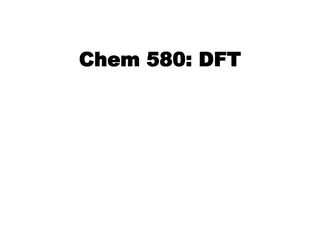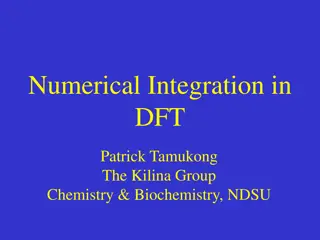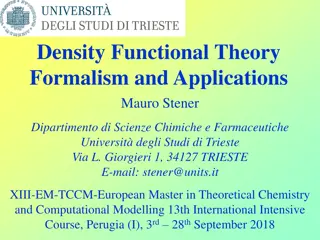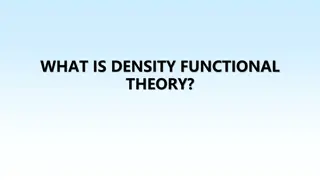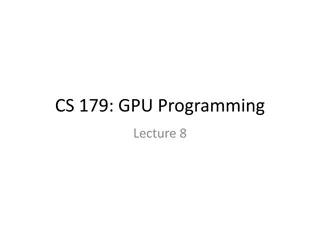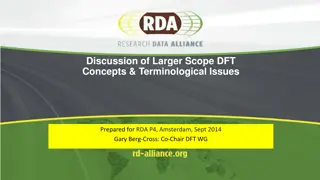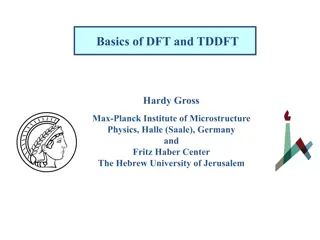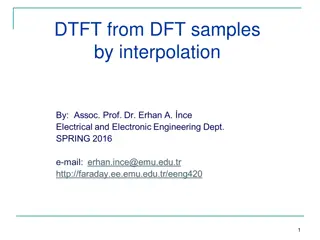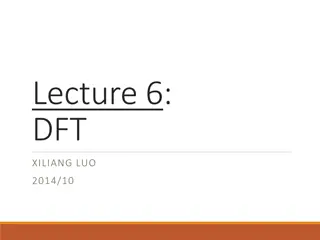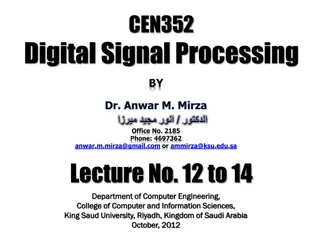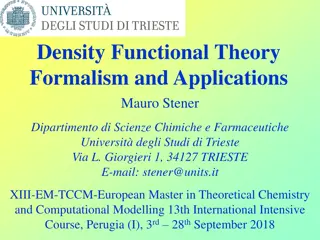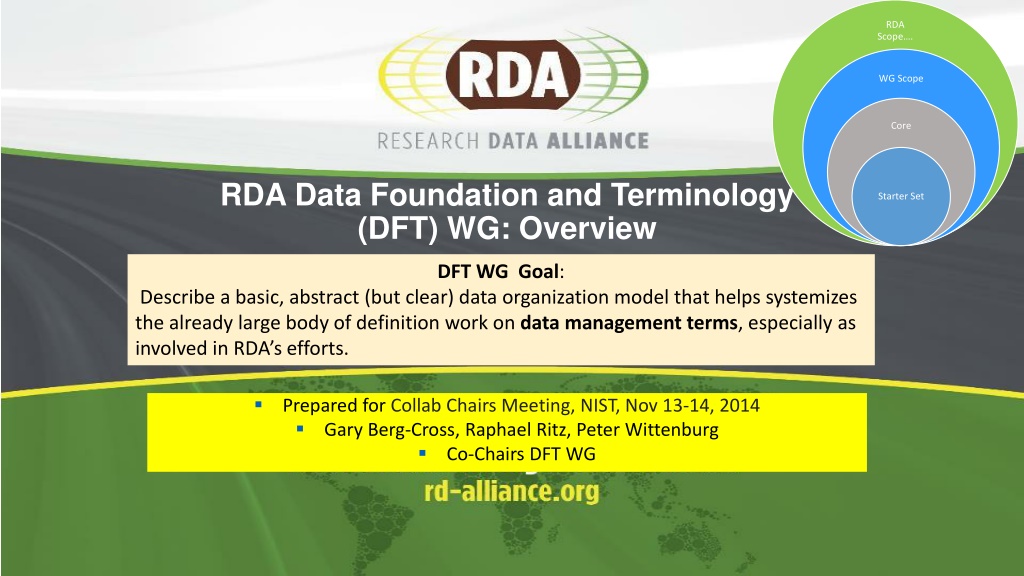
Advanced Data Management Models and Policies
Explore the development and implementation of data organization models and metadata extraction policies within the Research Data Alliance (RDA). This overview covers the activities and achievements of the Data Foundation and Terminology Working Group (DFT WG), highlighting key initiatives, collaborations, and discussions to advance the understanding of data management concepts and terminology.
Download Presentation

Please find below an Image/Link to download the presentation.
The content on the website is provided AS IS for your information and personal use only. It may not be sold, licensed, or shared on other websites without obtaining consent from the author. If you encounter any issues during the download, it is possible that the publisher has removed the file from their server.
You are allowed to download the files provided on this website for personal or commercial use, subject to the condition that they are used lawfully. All files are the property of their respective owners.
The content on the website is provided AS IS for your information and personal use only. It may not be sold, licensed, or shared on other websites without obtaining consent from the author.
E N D
Presentation Transcript
RDA Scope . WG Scope Core RDA Data Foundation and Terminology (DFT) WG: Overview Starter Set DFT WG Goal: Describe a basic, abstract (but clear) data organization model that helps systemizes the already large body of definition work on data management terms, especially as involved in RDA s efforts. Prepared for Collab Chairs Meeting, NIST, Nov 13-14, 2014 Gary Berg-Cross, Raphael Ritz, Peter Wittenburg Co-Chairs DFT WG
DFT WG Activities & Accomplishments Drafted 4 related Model Documents on core work; 1. Data Models 1: Overview 20 + models 2. Data Models 2: Analysis & Synthesis 3. Data Models 3: Term Snapshot 4. Data Models 4: Use Cases- Work with other RDA WGs on use cases to illustrate data concepts Drafted 2 page brochure Presented draft work & held community discussions at RDA P1- P4 meetings Participated in cross WG discussions Developed Semantic Media Wiki Term Tool to capture initial list of terms and definitions for discussions, demo held at P3 Candidate List Evolved to Refined List Tool demo at Plenary 3
Interactions with the other Groups Coordinated with several RDA WGs, as shown in the Figure on data concepts and relations. Participated in Garching meeting and Chairs teleconferences. Part of WG forum discussions A PID record points to a metadata record and to instantiations of identical bit-streams and may store additional attributes Processing model derived from about 125 interviews and interactions with community experts in addition to what DFT aggregated.
One View of DFT Scope from Process View One View of DFT Scope from Process View Policy defines this? 1. What elements are in a PID record 2. How to point to a metadata record? 3. What is in a metadata record at registration? 4. What is replication with identical vs. different bit-streams that may store additional attributes? We have policy for a minimum metadata record? The rest of data management and the lifecycle? Other WGs ..
Contextual metadata extraction policies Practical Policy WG area examples This policy area focuses on metadata associated with files and collections. Contextual metadata extraction Data access control The creation of provenance and descriptive metadata defines a context for interpreting the relevance of files in a collection. Depending upon the data source, there are multiple ways to provide metadata: Data backup Data format control Data retention Disposition Extract metadata from an associated document. An example is the medical imaging format DICOM. A start on minimal MD? Key processes across the data lifecycle? Integrity (including replication) Notification.. Extract metadata from a structured document which includes internal metadata. Examples are FITS for astronomy, netCDF, and HDF. Extract metadata by parsing patterns within the text within a document. Identify a feature present within a file and label the file with the location of the feature that is present within the file. Extract metadata Attribute_name Attribute_value Attribute_unit Source_file Source_collection
Basic Terms -Data Citation as Example Term Data Citation Definition Data Citation is the practice of providing a citation to data in a similar way that researchers routinely include a bibliographic reference to published resources. Examples References [[References::Australian National Data Service [ANDS], [2011], Van Leunen, [1992] Other sources: quoted from http://www.force11.org/node/4770, cited there as 'adapted from https://www.jstage.jst.go.jp/article/dsj/12/0/12_OSOM13-043/_pdf']] Related Term: Citable Data is a type of referable data that has undergone quality assessment and can be referred to as citations in publications and as part of Research Objects. Data Citation A citation is a formal structured reference to another scholarly published or unpublished work. In traditional print publishing, a bibliographic citation refers to a formal structured reference to another scholarly published or unpublished work. Typically, in-text citation pointers to these structured references are either marked off with parentheses or brackets, such as (Author, Year), or indicated by superscript or square-bracketed numerals although in some research domains footnotes are used. Such citations of a single work may occur several times throughout the text. The full bibliographic reference to the work appears in the bibliography or reference list, often following the end of the main text, and is called a reference or bibliographic reference. Traditional print citations include pinpointing information, typically in the form of a page range that identifies which part of the cited work is being referenced.
Objectives for Completing & Adoption 1. Facilitate community discussion on core concepts 1. We are updating products based on P4 discussions with our core communities and conversations on the Wiki. 2. Adoption Discussion and Take Up 1. We expect considerable discussion over time with adopters and with the DF IG that will serve to plan take up between P4 and P5. 1. Potential adopters were encouraged at P4 to provide feedback on additional use case scenarios to illustrate what areas of work they plan on using the models and vocabulary for. 2. Based on feedback, some curated revisions on definitions and the overall synthesis model can be expected to finalize and stabilize the effort for submission and subsequent use. 2. The WG will attempt to track this up take and adoption in order to facilitate adoption and prepare for exposition at P5. 1. During this initial adoption period from P4 to P5 we will, for example, attempt to gather and publicize success factors and critical issues, and encourage new (and outside) adopters such as the DataNet Federation Consortium and DataONE communities to use the DFT model.




